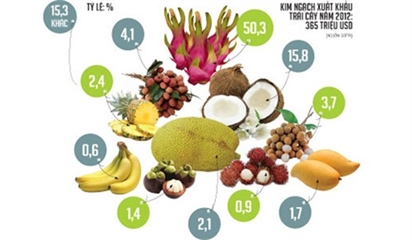|
Earning $1 billion, but fruit exporters can’t
get good night’s sleep
The fruit export
turnover keeps increasing steadily despite the global economic recession.
However, this is not enough to make Vietnamese exporters happy.
In 2013, Vietnam, for the first time,
earned $1 billion from fruit exports. A lot of Vietnamese fruits have become
favored in the world market, including dragon fruit, mango and rambutan.
Especially, Vietnamese rambutan
exporters have successfully dislodged Thailand
and Malaysia, the two
biggest rivals, from the US
market.
While Thailand
and Malaysia can only
provide rambutan seasonally, Vietnam
can export the fruit all year around. The great advantage has been taken by
Vietnamese enterprises to compete with Thai and Malaysian exporters.
However, farmers and exporters have
been warned that the export turnover growth may be unsustainable.
The story of pitaya
Market analysts have pointed out that
Vietnam’s fruits have been
exported mostly to China
across the border line, which consumes 64.5 percent of the total export
turnover.
The heavy reliance on the market
would make Vietnam suffer
once Chinese importers suddenly stop importing fruits from Vietnam.
Pitaya is an example. The pitaya
growing area in Vietnam
only accounts for 3.1 percent of the total fruit cultivation area, but pitaya
bring 55 percent of the total export turnover.
Vietnam is the biggest pitaya exporter in the world. However, its
major targeted market remains China,
which consumes 77 percent of the total output. Meanwhile, only four percent
is exported to Europe, 3 percent to the US
and 1.5 percent to Japan.
Meanwhile, many other countries,
including Thailand, the Philippines, US, Japan
and Israel,
have been trying to grow pitaya as well. China
has just successfully grown pitaya on a 20,000 hectare land area in Guangdong and Guangxi.
The pitaya area in the two Chinese
provinces alone is approximately equal to the total growing area in Vietnam
(25,000 hectares).
Will Vietnam’s pitaya fall into
disgrace in the world market in the future once there are so many new rivals?
When asked about this, Tran Ngoc
Hiep, Director of Hoang Hau (Queen) Pitaya Company in Binh Thuan province
said he still has not found the solution to the problem. The only thing he
can do is to take full advantage of the weather conditions.
“China can only grow pitaya in
June, July and August due to the weather and soil conditions. Meanwhile, we
can grow pitaya all year round. Therefore, we can export products in the
months when there are no Chinese products,” he explained.
Dr. Ngo Ngoc Trung Lap from the
SOFRI, a research institute, also said that Vietnam only can take the
advantage as the only grower in the world, while it is still weak at
technology and brand. These would be the big disadvantages for Vietnam, if
the other countries with advanced technologies also grow the fruits.
Also according to Lap, one of the
important things Vietnam
needs to do to penetrate more deeply into the world market is obtaining the
agreements with imports markets about the phytosanitary.
Meanwhile, it seems that Vietnam is
off the track when negotiating with other countries on the issue.
“I cannot understand why the
competent agencies have been focusing on negotiating with the markets which
set very high standards. Meanwhile, they have not thought of negotiating
about the standards with China,
the market which consumes 2/3 of Vietnam’s fruit exports,” he said.
Doanh Nhan
|

Không có nhận xét nào:
Đăng nhận xét